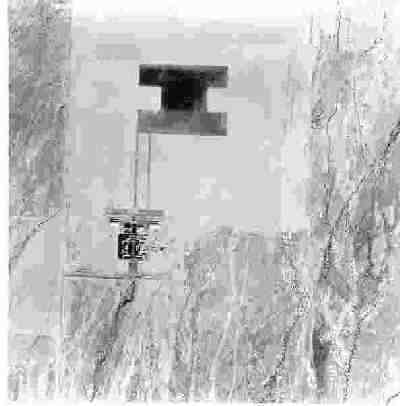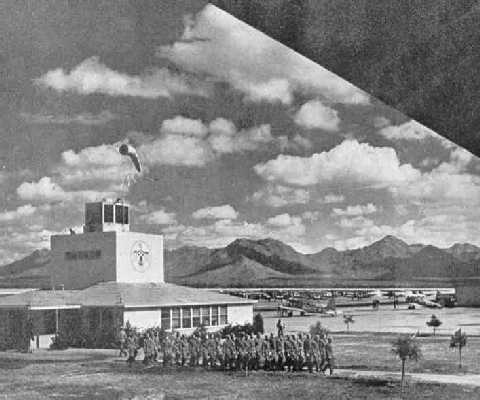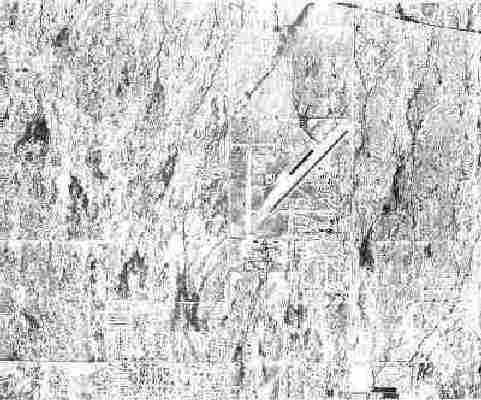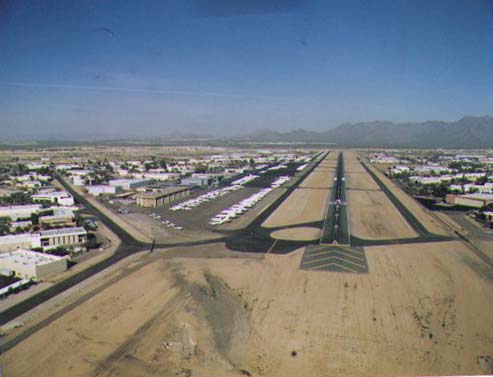
While in operation, Thunderbird II underwent a transformation that took it from a small piece of isolated desert to a primary training school. This transformation is attributable to visionary Air Force officers such as General H.H. Arnold and Lieutenant General B.K. Yount, and the civilian contract school operated by Leyland Hayward and John Connelly and supervised by Army Air Force personnel, who played a key role in creating a program that would help build the world's most powerful aerial striking force.
One of three Southwest Airways' training schools in the Valley, Thunderbird II's first class of cadets, arriving before the field was pronounced ready for occupancy, had to be trained at Thunderbird I in Glendale. Not until July 22, could all personnel, consisting then of 28 flight instructors, move to the Thunderbird II location in Scottsdale.

An increase in the number of students brought about a similar gain in the number of persons employed, until in January, 1944, Thunderbird II's payroll boasted 508 employees, with a total monthly salary expenditure of $115,247. Gradually the tempo slowed as World War II came to an end. So well did civilian contractors complete their initial assignment, that by August 4, 1944, only 40 of the original 64 primary schools were still in operation. At the closing of Thunderbird II, only 15 remained opened to complete the task of primary training. Thunderbird II's mission was accomplished - a great Air Force was built in far less time than anyone ever dreamed possible.
After the war, Arizona State Teachers College (now Arizona State University in Tempe, Arizona), acquired the airport in order to implement its own aviation program. Distance from the college campus and cost of operating an aviation program soon convinced the college to abandon its plans.
The Arizona Conference of Seventh Day Adventists purchased the Airport in 1953 and established Thunderbird Academy. Former barracks became dormitories. Hangars were adapted to house a wood products industry and a vocation education center offering training in mechanics, woodworking and welding. The airfield itself became a training field for missionary pilots. In 1963, in order to finance renovation of its physical facilities, the academy commissioned the first combined-use design of a clean industrial park surrounding an airport.
In 2017, there were around 400 aircraft based at Scottsdale Airport, from single engine recreational planes to numerous corporate jets.

In 2018, a new Aviation Business Center was built featuring a Stearman, historic aircraft similar to those flown during WWII at the airport, which is the centerpiece of the Thunderbird Field II Veterans Memorial.
Approximately 169,000 takeoffs and landings occurred in 2022, with making Scottsdale one of the premier general aviation airports with a single-runway airport in the country, and one of the busiest corporate jet facilities in the state.
Scottsdale Airpark, the 2,600-acre commercial area which surrounds the Airport, has become a national model for airport-based business parks. This model has been achieved through the efforts of numerous city of Scottsdale civic and community leaders. Several important factors have contributed to the success of the Scottsdale Airport/Airpark - it is headquarters for over 25 national/regional corporations; home to more than 2,500 small to medium-sized businesses; workplace of more than 48,000 employees; and has easy airport access and seven miles of taxiway access. The workforce within its boundaries has tripled in the past decade, making it the third largest employment center in the Greater Phoenix region.
